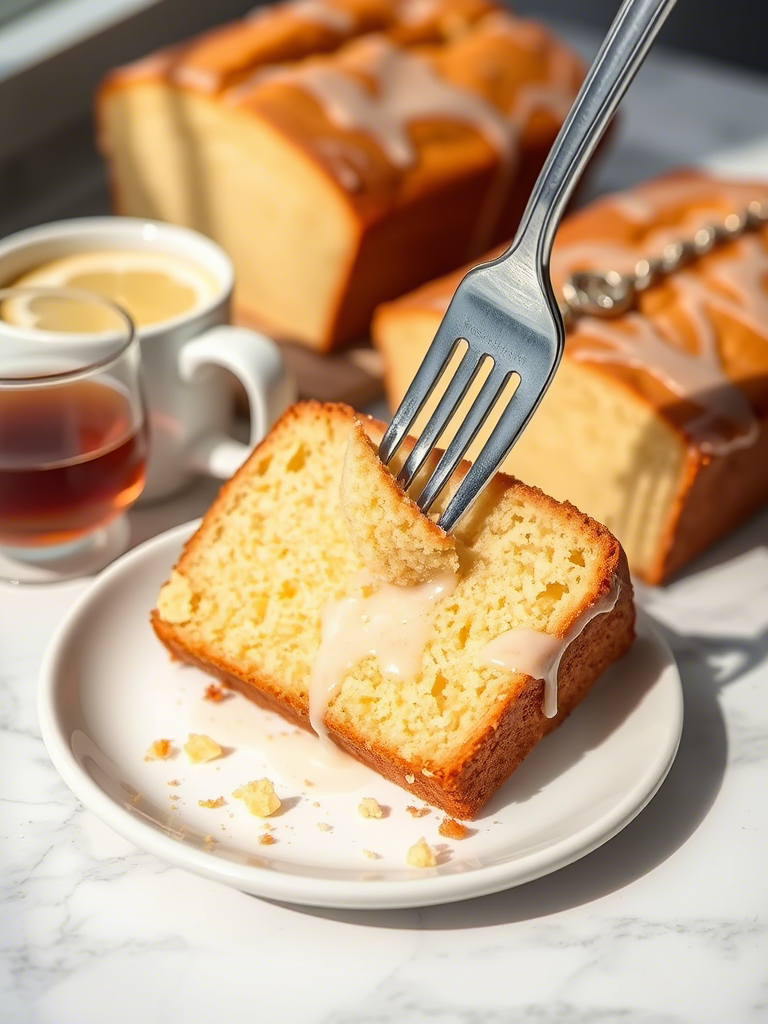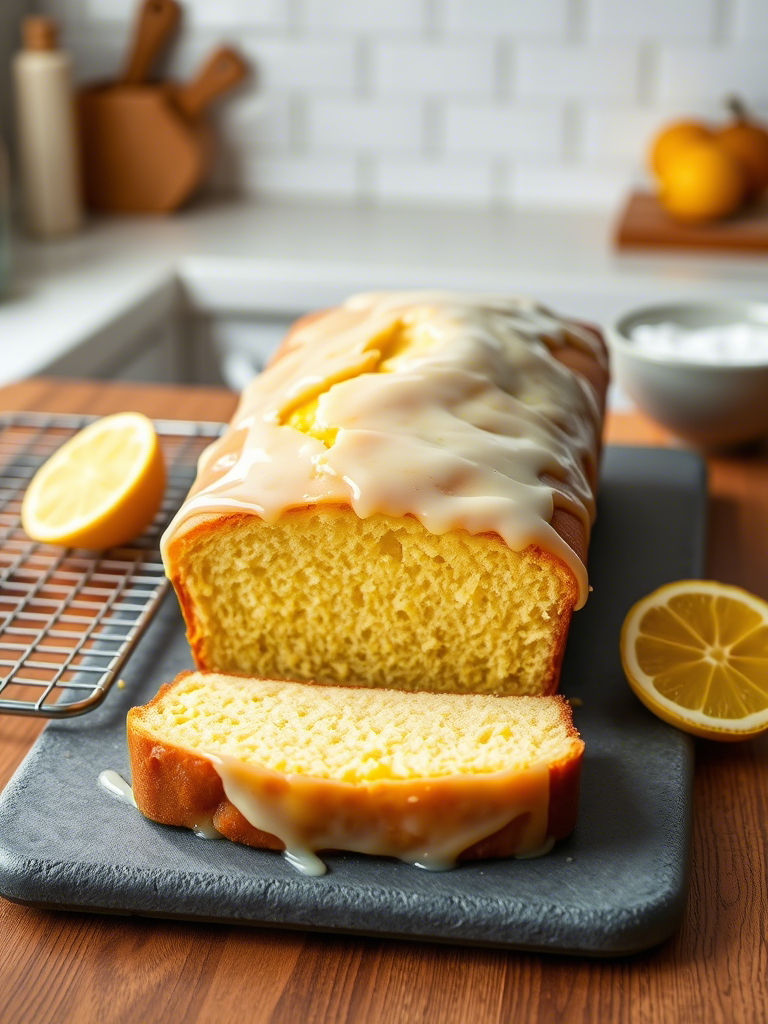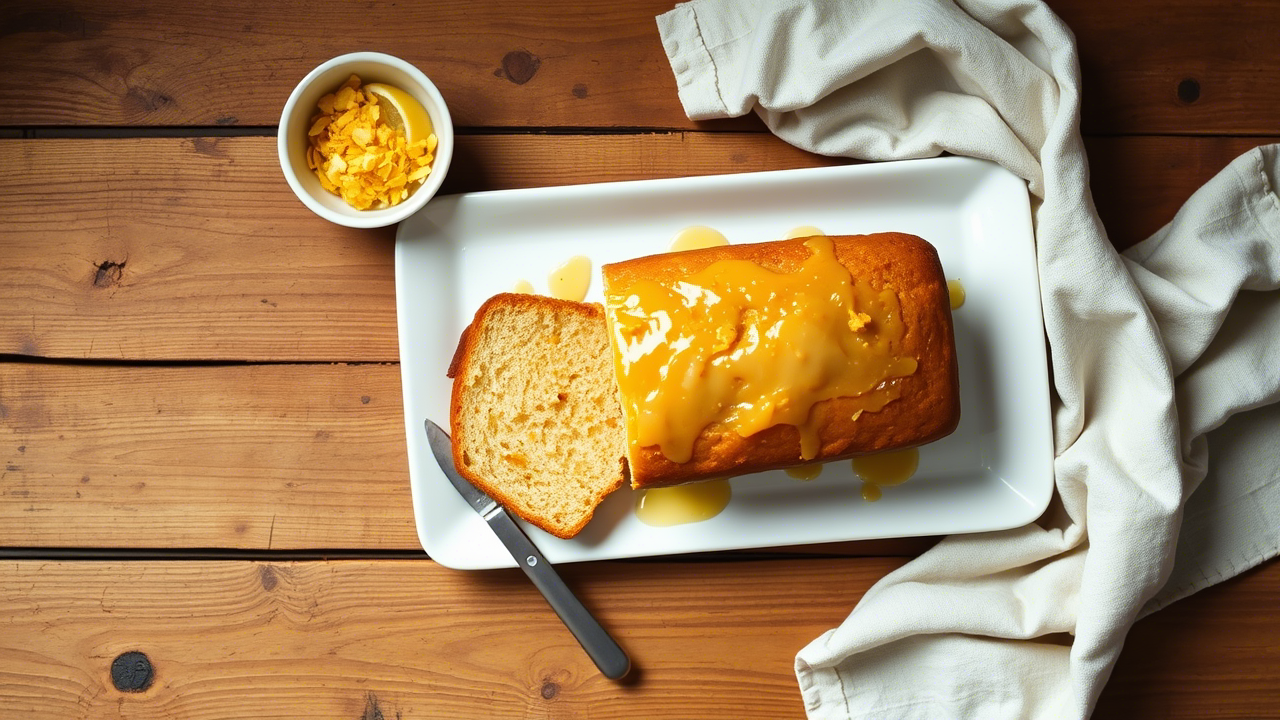That thick, moist, punchy slice of lemon cake at Starbucks—it’s kinda wild how one bite makes you want to sit down, close your eyes, and cancel your afternoon plans. But what’s really going on in that bright yellow loaf? And can you recreate that perfect, tangy slice of sunshine at home—without a corporate kitchen? Oh yes. And better. Let’s tear it all apart and build it back from scratch.
This isn’t your average food blog version where someone says “just throw in lemon extract and call it a day.” Nope. We’re going deep. Into the chemistry, the flavor layers, the moisture matrix, and that mysterious not-too-sweet glaze. Get your whisk—this ride’s gonna zing.
The Cult of the Lemon Loaf
There’s a reason the Starbucks Lemon Loaf has a borderline cult following. It’s not just cake. It’s memory. It’s the soft middle seat of sugar, tart citrus, and vanilla warmth. It somehow manages to be bright and buttery at the same time. That’s not an accident.
In fact, this slice is one of Starbucks’ best-selling bakery items. It regularly ranks among the top 3 pastries ordered with coffee. Why? Consistency. Moisture. And a flavor profile that balances acidity with fat in a way that’s frankly criminal.
But it ain’t magic. It’s food science.
What Actually Is the Lemon Loaf?
Professionally speaking, this is a pound cake—but with commercial tweaks. Most traditional pound cakes follow a 1:1:1:1 ratio of flour, butter, sugar, and eggs. Starbucks, though, leans heavier on fat and sugar to keep it moist and shelf-stable. And yeah, they cheat with preservatives. (We’re not doing that.)
Ingredients You’ll Find in Starbucks’ Version:
- Enriched bleached flour
- Sugar
- Eggs
- Vegetable oil
- Water
- Lemon juice concentrate
- Lemon zest
- Natural flavors (read: lemon extract, probably a hint of vanilla)
- Corn syrup solids (for the glaze)
- Xanthan gum, soy lecithin, and preservatives
That’s fine for mass production. But at home? We go pure.
Our Goal: Balance and Bounce
We’re chasing 3 things here:
- That plush, moist crumb that stays soft even the next day.
- True lemon flavor—not perfume, not just sour, but lemony.
- A glaze that sets like sugar glass but melts in your mouth.
Let’s start where flavor actually lives: in the fat.
Fat = Flavor Transport
Oil keeps things moist. Butter brings flavor. Commercial recipes use oil alone for shelf life. But butter… butter carries lemon zest in a way oil just can’t. It bonds with the essential oils in zest and acts like a megaphone for the citrus.
We’re using both. Because we’re greedy.
You’ll want unsalted butter (room temp, always room temp—don’t microwave it into sadness) and neutral oil like canola or grapeseed. Olive oil’s too bold here, sorry.

Real Lemons or Lemon Extract?
Both.
Here’s the trap home bakers fall into: they zest two lemons, maybe squeeze a bit of juice, and then wonder why it tastes like sugar bread. Zest gives you the floral top note. Juice gives acid. But it’s lemon extract that rounds the whole thing and makes it taste like you licked the sun.
Use pure lemon extract. Nielsen-Massey or Watkins if you can swing it. Not the fake stuff. And yes, combine it with fresh juice and zest. That trio is your holy trinity.
Pro tip:
Rub the zest into the sugar with your fingertips. This releases oils. Don’t skip it. It’s the moment where “okay” becomes “what is that smell?”
Eggs – Not Just for Structure
Eggs do more than hold things together. They add richness, emulsify fat and liquid, and help that golden crust develop. We want room-temperature eggs—cold ones shock the batter. And for color, use pasture-raised if you can. The yolks are sunset-orange and that makes your loaf look bakery-gorgeous.
How many?
Three large ones. Whisked, but not aggressively. Over-mixing introduces air, and too much air means it’ll rise high and collapse into a sad lemon puddle.
Buttermilk: The Silent Hero
This is where moisture gets real. Buttermilk is acidic. It reacts with baking soda to lift the cake, but also tenderizes the crumb. No buttermilk? Mix whole milk with a splash of lemon juice and let it sit 10 minutes.
Still, real cultured buttermilk gives that slight tang Starbucks loaf hints at but never fully leans into.
The Flour Question
All-purpose is fine. Cake flour makes it too soft; we don’t want it collapsing. But sift it. Twice. Don’t argue.
Baking Powder vs. Baking Soda
Both. You need the baking powder for lift, and soda for tang balance because of the buttermilk. Use fresh powder—check the expiration date. This isn’t 2019’s emergency stash.
Ratio:
- 1 tsp baking powder
- ½ tsp baking soda
Let’s Talk Glaze – The Secret Sweet Armor
That shiny glaze on top? It’s not just sugar. It’s the flavor echo chamber. Without it, the loaf’s just cake.
Use powdered sugar, lemon juice, and a touch of milk or cream. But here’s the pro move: add a tiny bit of melted butter to your glaze—like ½ tsp. It gives a slight sheen, a richness, and helps it set like the pros. Let the loaf cool completely before glazing or it’ll melt off like frosting on a hot day.
Bake It Right – And No Peeking
Use a 9×5 loaf pan. Grease it well and line it with parchment so it lifts out easily.
Bake at 350°F for 50–60 minutes. Tent with foil at the 30-minute mark if it’s browning too fast. A skewer inserted should come out with just a few moist crumbs—not wet, not bone-dry.
Let it cool in the pan 15 minutes, then on a rack until fully cool.
And no, don’t slice it warm. Yes, it smells like joy. Wait. Or it’ll crumble. Be patient.
Storage (If It Survives That Long)
Wrap it tight in plastic wrap. It stays soft for 3 days on the counter. You can refrigerate it for up to a week—but microwave slices for 10 seconds before eating. You want that bounce back.
It also freezes beautifully. Wrap in plastic, then foil, and store up to 3 months. Thaw at room temp, glaze after thawing.
Common Mistakes (Let’s Drag ‘Em)
Too much lemon juice: Makes it gummy. Acidity breaks down structure. More isn’t better.
Using only oil: You’ll miss that deep, bakery richness. Oil keeps it soft, but butter makes it sing.
Overmixing the batter: You’ll get tunnels and a weirdly rubbery edge. Mix until just combined, and no more.
Using bottled lemon juice: Just… don’t. It tastes like sadness and missed opportunities.
Pouring glaze on a hot loaf: All that work, melted into your counter. Tragic.

Expert Variations for Professionals
Want to take it next-level?
1. Add poppy seeds – A nod to lemon-poppy muffins. Adds texture and visual interest.
2. Infuse your sugar – Store your sugar with strips of lemon peel a week ahead. It pulls oils and perfumes your sugar base.
3. Brush the warm loaf with lemon syrup – Equal parts lemon juice and sugar boiled for 3 mins. Brush before glazing for double the zing.
4. Use Meyer lemons – A softer, slightly floral profile. Bakery chefs love using them in spring.
5. Bake in mini loaves for gifting – Reduce bake time to ~30 mins. Cute and smart.
Final Recipe Snapshot
Ingredients:
- 1½ cups all-purpose flour (sifted)
- ½ tsp baking soda
- 1 tsp baking powder
- ½ tsp salt
- 3 large eggs (room temp)
- 1 cup granulated sugar
- 2 tbsp lemon zest
- 1 tbsp lemon extract
- ¼ cup lemon juice (fresh)
- ½ cup buttermilk
- ½ cup vegetable oil
- ¼ cup unsalted butter (softened)
Glaze:
- 1 cup powdered sugar
- 2 tbsp lemon juice
- 1 tbsp milk
- ½ tsp melted butter
Instructions:
- Preheat oven to 350°F. Grease and line 9×5 loaf pan.
- Mix sugar and zest until fragrant. Add eggs, extract, juice, butter, and oil. Mix gently.
- Add sifted dry ingredients in batches. Alternate with buttermilk.
- Pour into pan. Tap to remove air bubbles.
- Bake 50–60 mins. Cool completely.
- Whisk glaze. Pour over cooled loaf. Let set.
The Takeaway
Nailing the Starbucks Copycat Lemon Loaf isn’t about hacking a recipe. It’s about understanding flavor layering, ingredient interaction, and bake technique. When you learn to combine oil and butter, when to punch with acid and when to whisper with extract—you’re not just baking. You’re composing.
This cake isn’t just a treat. It’s a masterclass in balancing structure with soul.
Once you’ve made it right? You’ll never want the store-bought again.
And that’s the best compliment you could ever give a loaf of cake.
FAQs
What makes Starbucks lemon loaf so moist?
A combo of oil, butter, and buttermilk keeps it ultra-moist and tender for days.
Can I use only lemon juice instead of lemon extract?
Nope—juice gives acid, but extract brings that bold lemon punch you actually taste.
What kind of oil works best in this copycat recipe?
Neutral oils like canola or grapeseed work great; olive oil’s too strong here.
Why should I rub lemon zest into the sugar?
It releases lemon oils, boosting aroma and flavor like wild.
Can I use cake flour instead of all-purpose flour?
Not really—it’ll make it too soft and likely to collapse.
How do I know when it’s baked perfectly?
A skewer should come out with a few moist crumbs, not wet batter.
Why both baking soda and baking powder?
Baking soda reacts with buttermilk, and baking powder lifts the loaf.
Should I glaze it while it’s still warm?
Nope—wait till it’s fully cool or the glaze melts right off.
How long will it stay fresh?
Up to 3 days at room temp, a week in the fridge if wrapped well.
Can I freeze the lemon loaf?
Yes—wrap it tight, freeze for 3 months, and glaze it after thawing.
What’s the best lemon extract to use?
Go for pure extract like Nielsen-Massey or Watkins—not the fake stuff.
Can I make mini lemon loaves from this recipe?
Absolutely—just reduce the bake time to about 30 minutes.
Why does Starbucks use oil only and not butter?
Oil makes it shelf-stable, but butter adds that rich, deep flavor we love.
Is bottled lemon juice okay?
Nah—it tastes flat and sad compared to fresh juice.
Can I add poppy seeds to this loaf?
Sure can—it adds a subtle crunch and bakery-style vibe.
Ask ChatGPT

Mariana is a passionate home cook who creates delicious, easy-to-follow recipes for busy people. From energizing breakfasts to satisfying dinners and indulgent desserts, her dishes are designed to fuel both your body and hustle.
When she’s not in the kitchen, she’s exploring new flavors and dreaming up her next recipe to share with the Foodie Hustle community.

